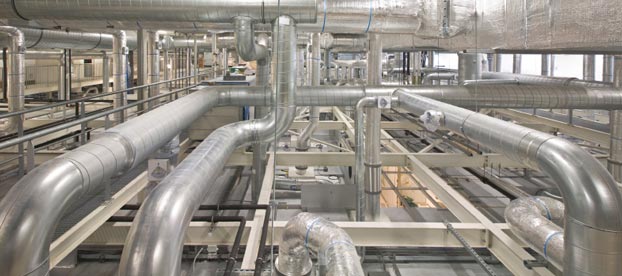Heating, ventilation and air conditioning systems, also known as HVAC, are found in just about every domestic and professional environment. They are responsible for making a space livable and tolerable by pushing through fresh air and moderating the temperature of the rooms and spaces they are installed in. Understanding the components that allow this type of system to function is important because it can help you determine an issue as it arises, or replace certain parts as needed. Here is the basic anatomy of a HVAC system.
The Furnace
The Furnace is typically the largest part of the HVAC system, and it requires a set amount of space for it to be installed, which is usually a garage or basement. The main function of the furnace is to push out the hot or cold air into the ducts that run through every room in the building. In these ducts there are small vents that permit the heated or cooled air to escape and adjust the temperature of the rooms individually.
The Evaporator Coil
Evaporator coils are attached to the furnace on the side of it in an enclosed metal structure. These parts are activated during a cooling cycle and supply cold air to the ducts and the vents. Evaporator coils look similar to a radiator in a car and are connected to the condensing unit of the system.
The Heat Exchanger
Much like the evaporator coil, the heat exchanger is also located inside the furnace unit. It becomes activated as soon as the furnace is turned on, and its main function is to bring in the cool air through the ducts, and heats it up to send the air back out again to bring up the temperature in the rooms. Electric units use electric coils and gas units use gas burners to get the job done.
The Condensing Unit
Condensing units are installed outside of the house and away from the furnace and other parts of the system. This part works directly with the evaporator coil by sending a liquid coolant through it after exchanging heat with the outside air. Once this liquid reaches the coil, it releases pressure by spraying it inside and turning back into a gas form. The evaporation taking place causes a drop in temperature and gives that colder air to the furnace blowers. This cycle is repeated to keep a fresh cool airflow.
The Refrigerant Lines
The refrigerant lines are tubes made out of metal that deliver the liquid to the evaporator coil and bring the gas back to the condensing unit. These tubes are typically made from copper or aluminum, and they are made to withstand very cold temperatures as they go about their functions.
The Thermostat
The thermostat is what controls the furnace function, and it is the part of the system inside the building where people can manage what the temperature of the room is. If the air is too cold, the heat exchanger works with it to warm it up, and if the air is too warm then the condensing unit works to cool it down.
The Ducts
Heating ducts are normally installed in each room somewhere on the ceiling. They are put into place so that the vents can be installed to control the room temperature.
The Vents
The usually rectangular shaped vents are also installed on the ceiling to correspond with the ducts. As the warm or cold air travels through the ducts, it is the vents that allow the temperature-controlled air to flow into each room. Vents are typically built with a metal frame that are sometimes capable of being adjusted to direct the flow of air coming through them.
Written by Ashley Hansen of Wayne’s Heating & Cooling in Moberly, MO who is the go to company for HVAC service!

